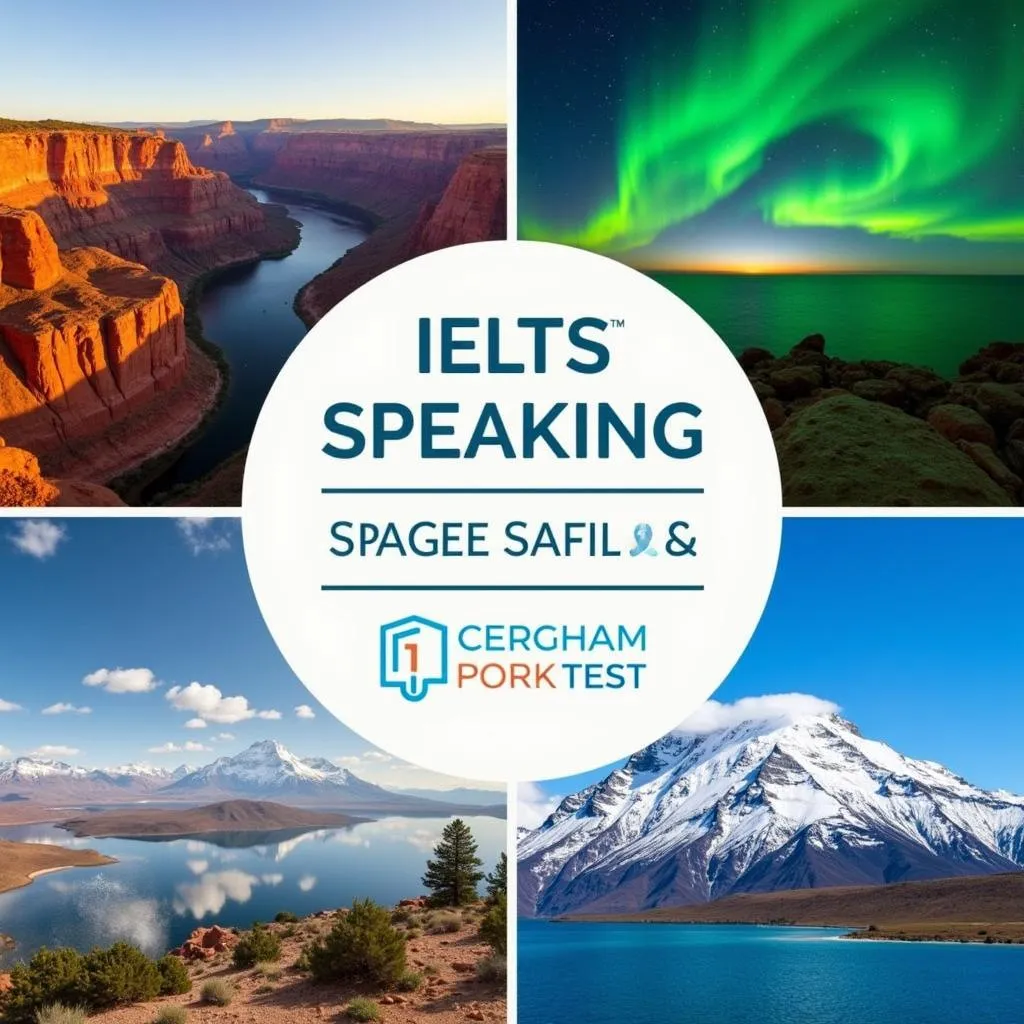Natural wonders are awe-inspiring locations that showcase the beauty and power of nature. They’re popular topics in IELTS Speaking tests, particularly in Part 2 long-turn questions. Being able to vividly describe a natural wonder you’d like to visit can help you score well on fluency, vocabulary, and coherence. Let’s explore how to tackle this topic effectively in your IELTS Speaking exam.
Nội dung bài viết
Part 1: Introduction and Interview
In Part 1, the examiner may ask some general questions about natural wonders or travel to gauge your ability to discuss familiar topics. Here’s a sample question with a suggested answer:
Q: Do you enjoy visiting natural attractions when you travel?
A: Absolutely! I’m fascinated by the raw beauty of nature. Whenever I travel, I make it a point to explore natural attractions in the area. There’s something truly magical about witnessing the grandeur of untouched landscapes and unique geological formations. It gives me a sense of wonder and helps me appreciate the incredible diversity of our planet.
 Natural wonders in IELTS Speaking test
Natural wonders in IELTS Speaking test
Part 2: Long Turn
In Part 2, you might receive a cue card like this:
Describe a natural wonder you would like to see.
You should say:
- What it is
- Where it is located
- How you learned about it
- And explain why you want to see itHere are sample answers at different band levels:
Band 6-7 Answer:
The natural wonder I’d really like to see is the Northern Lights, also known as the Aurora Borealis. It’s a spectacular light show that occurs in the sky in regions near the North Pole. I first learned about this phenomenon in my high school geography class, and since then, I’ve been fascinated by it.
The Northern Lights are visible in several countries, but I’ve heard that Finland is one of the best places to see them. The lights are caused by particles from the sun colliding with gases in the Earth’s atmosphere, creating beautiful, colorful displays in the night sky.
I want to see the Northern Lights because they seem so magical and otherworldly. The idea of watching waves of green, purple, and blue light dancing across the sky is incredibly appealing to me. It would be a once-in-a-lifetime experience that I think would leave me in awe of nature’s beauty.
Band 8-9 Answer:
The natural wonder I’m absolutely captivated by and eager to witness firsthand is the ethereal spectacle of the Northern Lights, scientifically known as the Aurora Borealis. This mesmerizing phenomenon manifests as undulating curtains of light that illuminate the polar skies in a kaleidoscope of vibrant hues, primarily in the Earth’s high-latitude regions.
I was initially introduced to this celestial marvel through a captivating documentary I stumbled upon during my undergraduate years. The film not only piqued my curiosity but also ignited a burning desire to experience this natural wonder personally.
While the Aurora Borealis is visible from several arctic and subarctic locations, I’m particularly drawn to the prospect of viewing it from Tromsø, Norway. This city, situated well above the Arctic Circle, is renowned for its optimal viewing conditions and extended periods of polar night, which significantly enhance the chances of witnessing this elusive phenomenon.
My eagerness to see the Northern Lights stems from a combination of scientific fascination and aesthetic appreciation. The idea that this breathtaking display is the result of solar wind particles colliding with atmospheric gases is mind-boggling. Moreover, the opportunity to stand beneath a shimmering, ever-changing canvas of greens, purples, and blues is, to me, the epitome of nature’s artistry. I believe such an experience would not only be visually stunning but also profoundly moving, potentially offering a moment of connection with the vast, mysterious universe we inhabit.
 Northern Lights or Aurora Borealis
Northern Lights or Aurora Borealis
Follow-up questions:
-
Q: Are there any challenges in seeing this natural wonder?
A: Indeed, viewing the Northern Lights can be quite challenging. The primary obstacle is the unpredictability of the phenomenon. It depends on solar activity and clear weather conditions, which aren’t always guaranteed. Additionally, the best viewing times often occur during the coldest months of the year, which can make the experience physically demanding. -
Q: How do you think tourism affects natural wonders like the Northern Lights?
A: Tourism can have both positive and negative impacts on natural wonders like the Northern Lights. On the positive side, it can boost local economies and raise awareness about the importance of preserving these phenomena. However, increased human activity in these areas can lead to environmental degradation and potentially disrupt the delicate ecosystems that make these wonders possible. It’s crucial to strike a balance between allowing people to experience these marvels and protecting the natural environment.
Part 3: Two-way Discussion
In Part 3, the examiner might ask more abstract questions related to natural wonders and tourism. Here’s an example:
Q: How can governments balance tourism and conservation of natural wonders?
Band 6-7 Answer:
Governments can balance tourism and conservation by setting strict rules for visitors to natural wonders. They can limit the number of tourists allowed in certain areas and make sure people follow guidelines to protect the environment. It’s also important to educate visitors about the importance of conservation. Governments can use money from tourism to fund conservation efforts and research. This way, they can allow people to enjoy natural wonders while also protecting them for future generations.
Band 8-9 Answer:
Balancing tourism and conservation is indeed a complex challenge that requires a multifaceted approach. Governments can implement sustainable tourism practices that prioritize the preservation of natural wonders while still allowing controlled access. This might involve establishing carrying capacities for popular sites and implementing timed-entry systems to manage visitor flow.
Additionally, governments should focus on educating tourists about the ecological significance of these areas and promoting responsible tourism practices. This could be achieved through interpretive centers, guided tours, and awareness campaigns that foster a sense of stewardship among visitors.
Furthermore, implementing a system of eco-taxes or conservation fees can generate funds directly from tourism to support ongoing preservation efforts. These funds can be allocated towards habitat restoration, scientific research, and the development of eco-friendly infrastructure.
Ultimately, the key lies in striking a delicate balance between accessibility and protection, ensuring that the awe-inspiring beauty of natural wonders can be appreciated by current and future generations without compromising their ecological integrity.
 Sustainable tourism at natural wonders
Sustainable tourism at natural wonders
Key Vocabulary and Phrases for High Scores
To elevate your IELTS Speaking performance when describing natural wonders, consider using these advanced terms and expressions:
-
Awe-inspiring /ɔː ɪnˈspaɪərɪŋ/ (adjective): Extremely impressive or daunting; inspiring great admiration.
Example: “The Grand Canyon is truly an awe-inspiring sight.” -
Breathtaking /ˈbreθteɪkɪŋ/ (adjective): Astonishing or beautiful in a way that makes you feel very excited.
Example: “The view from the mountaintop was absolutely breathtaking.” -
Mesmerizing /ˈmezməraɪzɪŋ/ (adjective): Capturing one’s complete attention as if by magic.
Example: “The dance of the Northern Lights is a mesmerizing spectacle.” -
Pristine /ˈprɪstiːn/ (adjective): In its original condition; unspoiled.
Example: “We hiked through pristine forests untouched by human development.” -
Biodiversity /ˌbaɪəʊdaɪˈvɜːsəti/ (noun): The variety of plant and animal life in a particular habitat.
Example: “The Amazon rainforest is renowned for its incredible biodiversity.” -
Ecotourism /ˈiːkəʊtʊərɪzəm/ (noun): Tourism directed toward exotic, often threatened, natural environments to support conservation efforts and observe wildlife.
Example: “Many countries are promoting ecotourism as a way to protect their natural wonders.”
Using these terms accurately and contextually can significantly enhance the sophistication of your responses, potentially boosting your vocabulary and coherence scores.
Examiner’s Advice
To excel in the IELTS Speaking test when discussing natural wonders:
-
Practice describing visuals: Regularly describe images of natural wonders to improve your descriptive language skills.
-
Expand your vocabulary: Learn and use a wide range of adjectives and phrases related to nature and landscapes.
-
Develop your ideas: Don’t just list facts; explain your thoughts and feelings about the natural wonder.
-
Use personal anecdotes: If possible, relate the topic to your own experiences or aspirations.
-
Stay focused: Ensure your answers are relevant to the question and maintain a logical flow.
-
Speak confidently: Even if you’re not sure about some details, express your ideas with conviction.
Remember, the key to a high score is not just about what you say, but how you say it. Aim for fluency, coherence, and a range of vocabulary and grammatical structures in your responses.
By following these guidelines and practicing regularly, you’ll be well-prepared to discuss natural wonders and other topics in your IELTS Speaking test. Good luck with your preparation!
Describe a waterfall or river you want to visit for more practice on describing natural water features. Additionally, you might find it helpful to describe a scenic drive you have been on to further enhance your descriptive skills for natural landscapes.


